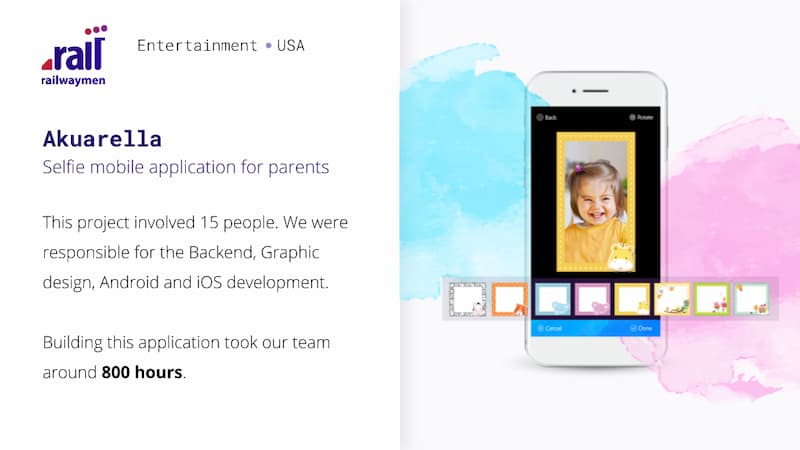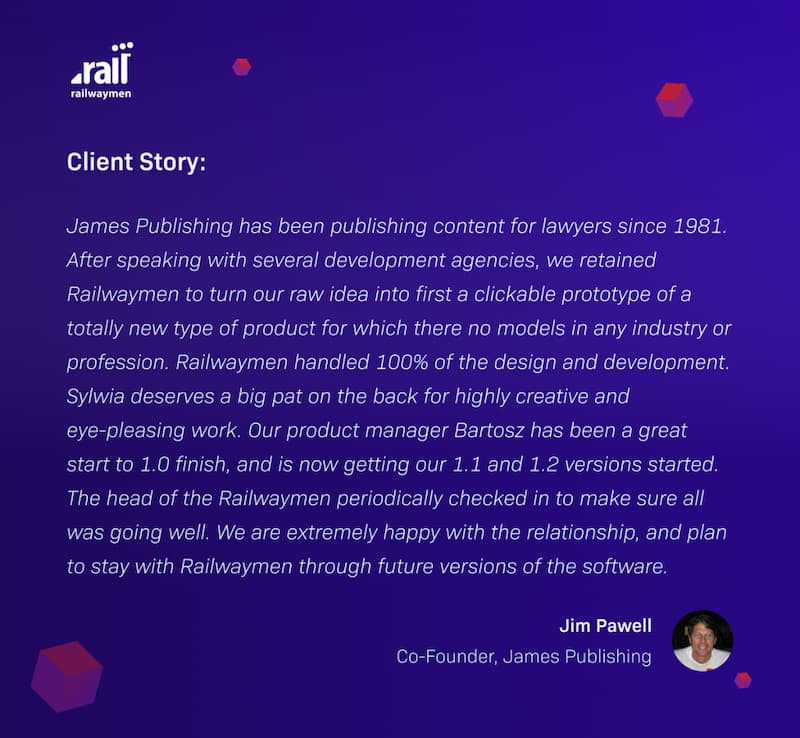App development is a complex process that requires adequate preparation and technical background. You can often come across questions on the web about how long such a project can take. The simplest answer would be the favorite statement of economists - “it depends”. But relax, I won't leave you with such an answer, and will explain in this article what it depends on. You will also learn what influences app development time and how to get a functional application by spending horrendous numbers of hours.
Table of Contents:
1. Understanding Mobile App Development Timelines
2. How long does it really take to build a mobile app?
3. How long does the mobile app development process take? [Simple one].
4. How long does it take to code an app? [A Complex App Example].
5. How long does it take to make a simple app?
6. How difficult is it to develop an app?
7. Key Stages in the App Development Process
8. Factors Influencing App Development Timelines
9. Strategies to speed up app development cycle
10. Post-Launch Considerations
11. What does it take to make an app? Years of experience!
12. Conclusion - how long it takes to build my app?
Understanding Mobile App Development Timelines
As you already know, the time required from the start of work on an application to its delivery into the hands of users can vary widely. The range is from 3 to 8 months. However, most often you have to reckon that the average development time is estimated between 4 and 6 months. The execution time for this type of project primarily depends on the complexity. The more technical meanders to go through, the preparation time can vary.
These are not the only factors that determine the commissioning of an app. The experience and size of the project team and the choice of the right platform are also very important. Depending on whether the app architecture will be for both Android and iOS, or a cross-platform development option, there may be differences in time. Nevertheless, it is worth making a mobile app development timeline to include all potential impediments in the implementation plan. This will avoid delays and at the same time prepare for all eventualities.
How long does it really take to build a mobile app?
I could finish this paragraph on using this beloved by the software houses phrase “it depends”. Because it really does - it’s much faster to build an app like Tinder (and cheaper) than to create a second Facebook. I cannot speak for other app developers but below I will show you how long did building specific apps from our portfolio take.
Simple Apps: Quick and Efficient
Work on a simple application containing basic functionality is usually a period of one quarter. This type of development is based on a simple idea, has a limited number of functions and is usually enclosed in five app screens. The development process is also a matter of about three months necessary to make this simple mobile app smooth and user-friendly.
Medium Complexity Apps: Balancing Features and Time
The preparation of applications with a medium degree of difficulty is slightly different. Among them are implementations for handling food orders. For this type of project app developers estimate to 7 months. This is because medium complexity apps are usually already equipped with more advanced features. API integrations, location services, use of camera capabilities, or custom UIs. These are just a few of the many examples that translate into app development services. The type of implementation described already requires investment in an extensive backend development environment and the ability to support multiple user roles.
Complex Apps: Extensive Development Time
In the last category are complex apps. They include projects designed for mobile banking with level login, or at least sophisticated accounting systems. In such cases, in addition to the implementation process itself, it is necessary to include time to train the team in the industry knowledge that is necessary for the proper functioning of the application. These are the most complicated implementations, as they often require top-notch security, high competence of the development team and almost flawless execution. All of this is done in order to inspire the highest possible trust in the user and to provide them with a safe space every time they use the application.
How long does the mobile app development process take? [Simple one]
Let’s start with a simple app example. Akuarella is a mobile app (both for Android and iOS devices) that helps parents spontaneously capture the smiles and joy of their babies and children. This selfie application is targeted at parents who want to take the perfect picture of their children with a natural smile with ease, without them even knowing.

read the whole case STUDY HERE
In this case, the whole app development process took around 800 hours. But bear in mind, that it wasn't “just” a development part. Our development team made this app from A to Z - prepared the whole UX / UI Design side (graphic materials, user stories, and more), back end, provided Project Management services, and as the result, made two, separate native mobile apps (iOS and Android). We believe, that this kind of approach (full in-house) helps to make truly savvy apps! If you have some of these things ready (for example graphic designs), the time will be shorter.
So in general, 15 people from our company were somehow engaged in this mobile app development project, when there was a need for their services. So at the first sight, 800 hours might look like a lot - but if you count how many people are engaged in the project at the same time, the whole development time wraps around 3 months to have your mobile app live and see it in the Apple App Store!

This specific app had a clear goal from the very beginning. It was specially designed for famous Puerto Rican actress Adamari López and her daughter Alaïa. All the profits from the app were donated to St. Jude Children's Hospital in Tennessee, USA. So it wasn’t one of these apps that needed to be constantly developed and maintained.
How long does it take to code an app? [A Complex App Example]
Now let’s move to the second example, of a more advanced application. James Marketing Amplifier App is a marketing automation web application for the law industry. The purpose is to help them improve their marketing to obtain more and better clients. James Marketing Amplifier offers high-value law content that can be sent to segmented clients through email campaigns. With this online tool, law firms receive more signups from their website, acquire customers through referrals, grow and improve educational content on their blogs.

Making the app 1.0 version live took our team around 1200 hours. This project involved 7 people: Project Manager, UX/UI Designer, Quality Assurance Specialist, two Front-end Developers, and two RoR Developers. Fun fact - we released this app in the middle of the first wave of the COVID-19 pandemic! The whole development part of this app version (not counting estimations etc.) took us around 4 months.
After releasing the first version of the app, we’ve almost instantly moved to further development, as based on the users' feedback ideas for new functionalities and amendments came naturally.
Important note: it is ALWAYS our clients' decision, whether they want to further develop their app. We’re providing them with fully functional, bug-free, and stable software - it’s not like with computer games, where you almost always have to download the Day-1 patch.

So you can always end your work at the chosen scope and end up with a perfectly working app. But if along the way, you will notice that your target audience has changed or spotted out some new business opportunities - we will be there, to come back to growing your software. Whether it will be weeks, months, or years - we’ll be there.
How long does it take to make a simple app?
First, we need to determine whether we’re on the same page as a “simple app” is. Building the second Uber is NOT a simple app. Because despite the fact that this is an app that is already live - we don’t have access to source code to just take it and adjust it to your needs. The same situation applies to apps that seem to be simple at first look. Let’s take one of our foodtech apps for example.
From the user perspective - it’s a pretty basic, food ordering mobile app. But the real complexity hides in the app integrations (with NCR POS system or popular in the GCC regions Mada cards) and the Admin Panel that is available to the app owner.
But let’s say that your application is really simple (something like Smoke-Free app that is mainly a content-based app, which aims to motivate you to quit smoking). In this case, building an MVP shouldn’t last longer than 3 months.
How long it takes for a development agency, to finish the app started by someone else?
There is one additional matter I want to cover here, which is time-related. We often encounter a situation at Railwaymen, when someone comes to us and says that he/she has got an app finished in 70 % (the question is - how poor of a freelancer/software house you’ve chosen, that he/she/they couldn’t get it 100 % done?) so he/she expects that we can take over the app and get it done within a month or so. Unfortunately, that’s not how it goes.
Imagine the situation when you’re a book author and you are asked to finish the book that someone else started to create. First of all: most of the authors wouldn’t agree to that and would propose writing it once again from scratch with similar characters, plotlines, etc. And the ones that would agree to finish someone else's work, would need extra time to read thoroughly the part already done, to understand it and avoid any loopholes in the storyline or pure nonsenses.
The same goes for app development. If we receive a code after someone else - we will look at it. But if it will be garbage - we’re very sorry, but the only way to save the software idea itself is to make the app once again from scratch. Reach to us, if you struggle with a similar situation - our experts will carefully review your code, and find the best solution to maintain the app quality.
How difficult is it to develop an app?
And how difficult is it to be a doctor? Well, it all depends on whether you finished medical school and worked in the hospital or not :) It is always a very complex matter, but for people who are doing it for 11 years already, and finished over 125 projects it will be certainly much easier than for business owners, who don’t understand the difference between Java and JavaScript (nothing to be ashamed of - we don’t have to be experts in everything!).
Key Stages in the App Development Process
Understanding the key stages of mobile app development is essential for realistic project scheduling and effective resource management. The process can be broken down into six major phases, each of which plays an important role in delivering a refined and functional final product:
Market research and idea validation
Duration: 3-6 weeks
This phase involves validating business and technological assumptions. It includes an analysis of the market, competition, user expectations and the needs of the target audience. At this stage, the so-called product discovery is also created, i.e. clarification of MVP (Minimum Viable Product) functionality. The result should be a clear plan of the application's functions and preliminary product documentation.
Prototyping and interface design (UI/UX)
Duration: 2-3 months
The design phase includes the creation of mock-ups (wireframes), clickable prototypes and complete UI designs. Appropriate emphasis is placed on usability (UX), intuitive navigation and visual consistency with the brand identity. Iterative testing with users can add additional time, but significantly reduces the risk of later revisions.
Coding and application development (frontend + backend)
Duration: 3-6 months (or longer for complex projects)
This is the most intensive phase, where developers create the presentation layer (frontend) and server logic (backend). Depending on the complexity, the number of integrations with APIs, payment systems, authentication or databases - the time can vary significantly. In cross-platform projects (e.g., using Flutter or React Native), part of the code may be shared between platforms.
Testing and Quality Assurance (QA)
Duration: 3-6 weeks
In this stage, the application is tested for functionality, technical and performance. Includes manual, automated, regression and security testing. The implementation of unit and integration tests significantly affects the stability of the product and reduces the time for post-implementation bug fixes.
Implementation and publication
Duration: 1-2 weeks (plus time for approval in the stores)
Publishing an app in the Google Play and Apple App Store involves a formal process that can take from a few hours to a few days (especially for Apple). Before publication, it is worth taking care of beta testing (TestFlight, Play Console), analytics and backend configuration for scalability.

Factors Influencing App Development Timelines
Several factors influence app development timelines, including the app’s functional content, feature set, and backend setup. Proper planning and allocating adequate time for each development stage are crucial for timely app delivery. Experience and team size also play significant roles in determining the overall development timeline.
App Complexity and Features
The more complex the application - in terms of number of screens, user roles, business logic or integrations - the more development time is required.
Example: A simple application with a login, dashboard and form can be developed in 2-3 months. In contrast, a marketplace-type application (e.g., with buyer and seller accounts, payment system, geolocation and chat) can take 6 to 12 months.
Each new functional component increases not only coding time, but also testing and maintenance.
Platform Choice: iOS, Android, or Cross-Platform
Native apps for iOS and Android require separate versions of code, which doubles some of the effort. Cross-platform frameworks, such as Flutter or React Native, allow for a common code base for both platforms, which can reduce development time by as much as 20-40%.
For web applications, it's worth keeping in mind the need to adapt the interface to different resolutions and browsers, which also affects development time.
Experience and organization of the team
The experience of the team directly translates into the quality of the code and speed of work.
A small team (2-3 people) can be effective for small projects, but larger applications require broader competencies: frontend, backend, UX/UI, QA, DevOps, and often a business analyst.
Teams experienced in Agile methodologies are able to identify obstacles and iterate on the product faster, reducing the risk of delays.
Quality of documentation and project preparation
Lack of precise functional and technical requirements at the start significantly lengthens the project. Changes during development (scope creep) can result in code refactoring and delays.
Therefore, precise specifications, UX mockups and a backlog of prioritized features are essential to keep the project on track.
Third-party integrations and certifications
Each additional integration - e.g., with a payment system (Stripe, PayU), maps, social login, CRM or ERP - means more days or weeks of work.
In addition, applications requiring regulatory compliance (e.g., RODO, HIPAA, PCI-DSS) must pass security testing and legal documentation, which also impacts the schedule.

Strategies to speed up app development cycle
Accelerating project implementation is not just about increasing the number of developers. The key is a conscious approach to scope, technology and workflow. Here are proven strategies that realistically reduce time without compromising quality.
Building an MVP (Minimum Viable Product)
Rather than deploying a full product right away, it makes sense to start with an MVP - that is, a version containing only the key functionalities needed to validate the idea commercially.
Benefits: MVP allows you to minimize the time-to-market (aka time-to-market), get real feedback from users, and save budget for development of actually needed features.
MVP implementation time: 2-4 months with average project complexity. Use of off-the-shelf components and services. Not all application components need to be written from scratch. For example, you can use Firebase for the backend, Auth0 for login, Stripe for payments or Mapbox for geolocation.
It is estimated that using off-the-shelf SDKs and libraries can reduce development by 15-30%, especially in the first phase of a project.
Test automation
Manual testing of each version of an application is time-consuming and costly. The use of automated tests (e.g., unit tests, integration tests, E2E) speeds up the detection of errors and makes it possible to fix them on the fly. Regression testing, in particular, is invaluable with each new version of an application.
Agile and the iterative approach to development
Instead of the cascade (waterfall) model, which requires full specification and closure of one phase before the next, the Agile approach enables iterative building of applications in short sprints (e.g., 2-weeks). Each sprint ends with a working version, allowing rapid response to changing requirements. It also allows you to start testing earlier and optimize the process in real time.
Well-planned architecture
Choosing the right technology stack and a well-thought-out architecture (e.g. microservices vs. monolith) at the start of a project significantly reduces the risk of errors that can cost dozens of man-hours in later refactorings.
Post-Launch Considerations
The release of an application is only the beginning of its life cycle. Post-release maintenance, development and optimization are critical to its success and continued growth.
Monitoring and Bug Fixing
After deployment, there may be bugs that were not detected during the testing phase. It's worth implementing monitoring systems (e.g., Firebase Crashlytics) and setting up alerts so the team can respond quickly. Time to implement patches: usually 1-3 days.
Updates and platform compatibility
Operating systems change regularly, which may require adjustments in the application. The recommended update frequency is every 4-8 weeks. This requires scheduled development and testing time.
Analyze user data
Analytics tools (e.g., Mixpanel, Firebase) help understand how users are using the application. Analyzing retention, abandonment and conversions helps optimize features and UX.
User support and feedback handling
Responding to reviews, responding to support tickets and collecting suggestions is an essential part of maintaining a positive app experience.
Further feature development
Based on data and feedback, future versions of the app are planned. The development time for new features depends on their complexity, but is usually in the range of 2-6 weeks per iteration.
What does it take to make an app? Years of experience!
One of the biggest factors that influence the app development time is the number of Senior Developers that the app development company has got on board. Naturally, they will require less time to learn things needed to create your app, as they’ve already encountered similar challenges in their previous projects. In our company, we have more Senior RoR devs than juniors & regulars combined (at the time I'm writing this article, it’s 12 vs 8, without counting the CTO)! Check our meet the team page and see for yourself.
Our programmers, QA Specialists, UX Designers, and Project Managers are building savvy apps for years already and they're sharing their knowledge on our company blog (check the web development, mobile development and product design categories to see for yourself).
Conclusion - how long it takes to build my app?
So as you see there is no clear answer to the question of how long does it take to make an app. I’ve presented you with some examples from our company with the exact numbers - hope it will give you a better understanding, as you look at these apps and compare them to your own app idea. Ultimately the best way to find out how long does it take to finish your app development process is to contact us. No matter, whether its'a mobile app development project or web - its time & prize estimation is 100 % free with us. And who knows - maybe it will turn out that the funds you already have are more than enough ;)
Remember as I said that the app development world now is similar to playing on the stock? It’s far less hazardous and uncertain than it was a few years ago and that’s because the research BEFORE making an application is becoming more and more important.
And in our company, that research period is called Product Design Workshops. Based on that service, you will not only receive a detailed estimation of how long the building your app will take but what functionalities it should have at the very beginning, which clients you should focus on, and generally verifying, whether your idea makes sense.




